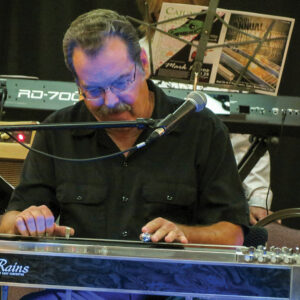Dave Flanagan remembers when pedal steel guitars first captured his attention. “Even when I was 4 or 5 years old, I would hear one and I’d stop in my tracks to listen,” he recalls. For the resident of the small Jefferson County community of Texico, the fascination with the instruments never waned.
“They always have been intriguing to me. They don’t sound like any other instruments,” he says.
That’s because a pedal steel guitar is not like any other instrument. Although there are some similarities, pedal steel guitars are unique. Like its namesake the guitar, it features six to 10 strings stretched across a neck. As with a banjo, players pluck strings with finger picks worn on the thumb, index and middle finger of the right hand. Like a piano, players are seated when they play, and like drums, playing one requires both hands (one picking the strings and the other sliding a “bar” across the strings) and both feet.
Pedal steel guitars are rather complicated, with one or two playing necks across the top of the console, a number of pedals on the floor and a series of knee levers. The pedals and levers give players the ability to instantly change the tuning of the instrument, allowing for a wider range of notes and tones – and multiplying the difficulty of playing the instrument.

“I grew up in a musical family,” Flanagan says. “Growing up, I played drums, guitar and bass, but I was still intrigued with the steel guitar.” He remembers finally buying his first pedal steel guitar around the age of 30. “It’s all I play now, but it was probably the most difficult instrument I’ve ever tried to play. Every time you move a pedal or a lever, it changes the tuning of the whole thing.”
Accomplished multi-genre fiddle player and musician Dennis Stroughmatt of Albion agrees. “I play one somewhat, very tepidly,” he says. “The thing is, with the levers and pedals, you almost have to be a rocket scientist to understand it. You have to have a real grasp of cord theory. I have the utmost respect for good steel guitar players because if you can master it, you can master almost anything. I think it is way more difficult than the fiddle, guitar or banjo.”
Flanagan explains, “For example, the tuning on a piano is constant. A key on the piano such as middle C is always a C. On a steel guitar, you can change it as many ways as you have pedals and levers and a combination of them. That C on the piano will never change, but imagine if you could change that single key to a C-sharp or a D or an A or even a B. It makes the steel guitar risky because nothing stays the same. It’s like trying to learn to play six different instruments at the same time.”
Stroughmatt is well-versed in the history of American music and instruments. He says the ancestors of pedal steel guitars are “slack” guitars, native to Hawaii, and lap guitars. Adding that when solid body and amplified lap guitars were developed in the 1930s, console guitars with legs emerged.
“Really the whole idea of the pedal steel guitar came in the early 1950s as players wanted to be able to get more “bends” than the bar alone will allow. The pedals give that flexibility,” he says.
The sound became synonymous with country music in the 1990s, especially western swing and traditional country music.
“Pedal steel guitars are extremely important in traditional country music,” Stroughmatt adds. He says while the instrument is not as prominent in much of today’s popular country, many of today’s top artists still utilize pedal steel guitars.
“Those with more traditional influences like George Strait, Jamey Johnson and Brad Paisley still feature pedal steel guitars,” he says. “Jason Aldean won’t perform without one.”
“Without it, traditional country music is not the same; the sound just isn’t there,” he says. “I don’t think it’s ever going to go away. It may not be as prominent and as big as before, but pedal steel guitars will still be around.”
Flanagan explains that there are several reasons the instruments are not as popular as before.
“I’ve been asked why there are no young steel guitar players, and I think if they want to play a piano or guitar or fiddle, you can get one very reasonably, but steel guitars are so expensive, it can be prohibitive,” he says, adding that not only is there the instrument – which will run $2,000 to $10,000 – but also the cost of slides, amplifiers and more. “That’s why we don’t see many young people playing. Most people are learning in their 30s.”
Despite the steep learning curve, Cummings says he believes much of country music is rediscovering pedal steel guitars, and players like him are continuing to spread the word. He participates with a not-for-profit group called Southern Illinois Productions, which holds an annual steel guitar convention held each April in Mount Vernon. The 18-year-old “Steel Guitars in Concert” event (originally called the Southern Illinois Steel Guitar Show) brings together professional players, enthusiasts and country music fans for three days of music.
“I’m guessing we’ll have 30 professional pedal steel guitar players this year,” says Cord Fitch of Thompsonville, one of the founders and organizers of the event. “There were probably 100 people at the first one, now we have as many as 2,500 during the weekend. When we started, we were just a little show, now we are the second or third largest in the country.”
Fitch says he always hopes that Steel Guitars in Concert will inspire, just like a convention did for him.
“I went to a show in St. Louis in the 1980s,” he recalls. “I played the fiddle and guitar, but I would listen to steel guitar players and I said, ‘One of these days, I’m going to play one of those.’ About a month later, I bought a pedal steel guitar. I put my fiddle and guitar down and have never touched them since.”










